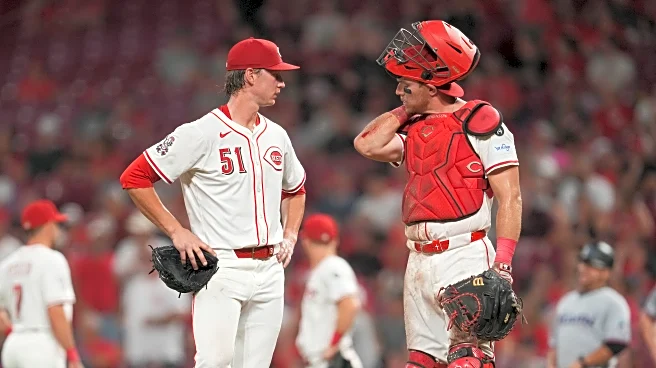What's Happening?
The Cincinnati Reds are entering a crucial offseason with several players up for salary arbitration. Notable among these are Matt McLain and Spencer Steer, who are projected to earn $2.6 million and $4.5 million respectively, according to MLB Trade Rumors' algorithm. Other players facing arbitration include Gavin Lux, Tyler Stephenson, Brady Singer, Nick Lodolo, Will Benson, and TJ Friedl, with Lodolo projected to earn $4.3 million. The Reds have few notable free agents, allowing them to maintain a stable roster as they look to improve their performance in the 2026 season. The team aims to build on their playoff appearance in 2025, despite facing strong competition from the Milwaukee Brewers and Chicago Cubs in the NL Central.
Why It's Important?
The arbitration outcomes for the Cincinnati Reds will significantly influence their financial flexibility and strategic planning for the upcoming season. By retaining key players through fair arbitration values, the Reds can focus on enhancing team performance without the pressure of acquiring high-cost free agents. This stability is crucial as they aim to transition from a playoff contender to a team capable of advancing further in the postseason. The Reds' ability to compete effectively in the NL Central, a division with formidable opponents, will depend on their roster management and player development during the offseason.
What's Next?
The Reds will focus on finalizing arbitration agreements with their players, ensuring that they maintain a competitive roster for the 2026 season. The team may also explore strategic acquisitions to bolster their lineup, aiming to address any weaknesses exposed during the 2025 season. As the arbitration process unfolds, the Reds will need to balance financial constraints with the goal of improving their postseason prospects. The team's management will likely monitor player performance and market opportunities closely to make informed decisions that align with their long-term objectives.
Beyond the Headlines
The arbitration process highlights the broader economic dynamics within Major League Baseball, where teams must navigate player salaries and market conditions to remain competitive. For the Reds, maintaining a stable roster through arbitration reflects a strategic approach to team building, emphasizing continuity and gradual improvement. This approach may influence other teams facing similar challenges, as they seek to balance financial prudence with competitive aspirations. The Reds' focus on internal development and strategic acquisitions could set a precedent for mid-market teams aiming to enhance their postseason potential.











